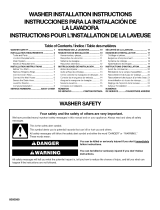
24" (61 cm) & 27" (69 cm) Gas Washer/Dryer
Installation instructions
Instructions pour I'installation de la laveuse/s_cheuse
gaz de 24" (61 cm) et 27" (69 cm)
Instrucciones de instalaci6n de la lavadora/secadora
del gas de 24" (61 cm) y 27" (69 cm)
Table of Contents
WASHER/DRYER SAFETY .......................................................... 2
INSTALLATION REQUIREMENTS ............................................... 5
Tools and Parts ..................................................................... 5
LOCATION REQUIREMENTS ...................................................... 7
DIM ENSIONS/CLEARANCES ..................................................... 8
DRAIN SYSTEM ......................................................................... 10
ELECTRICAL REQUIREMENTS ................................................ 11
GAS SUPPLY REQUIREMENTS ................................................ 11
REMOVE SHiPPiNG STRAP ...................................................... 13
INSTALL LEVELING LEGS ......................................................... 14
REMOVE FOAM PACKING (24" models) .................................. 14
VENTING ..................................................................................... 15
Venting Requirements ........................................................ 15
Plan Vent System ................................................................ 16
Install Vent System ............................................................. 17
CONNECT DRAIN HOSE ........................................................... 18
CONNECT iNLET HOSES .......................................................... 19
MAKE GAS CONNECTION ........................................................ 21
CONNECT VENT ........................................................................ 21
LEVEL WASHER/DRYER ........................................................... 22
COMPLETE iNSTALLATiON CHECKLIST ................................ 23
Table des mati_res
SECURITE DE LA LAVEUSFJSECHEUSE ................................ 24
EXlGENCES D'INSTALLATION ................................................. 27
Outillage et pi_ces ............................................................. 27
EXlGENCES D'EMPLACEMENT .............................................. 29
DIMENSIONS/DISTANCES DE DEGAGEMENT ....................... 30
SYSTI_ME DE VIDANGE ............................................................ 32
SPECIFICATIONS leLECTRIQUES ............................................ 33
SPleCIFICATIONS DE UAMMENTATION EN GAZ ................... 33
ENLEVER LA SANGLE D'EXPEDITION .................................... 35
iNSTALLATiON DES PIEDS DE NIVELLEMENT ...................... 36
ENLEVER L'EMBALLAGE EN MOUSSE (modUles de 24") ..... 36
EVACUATION ............................................................................. 37
Exigences concernant I'_vacuation ................................. 37
Planification du syst_me d'6vacuation ............................ 38
Installation du conduit d'_vacuation ................................ 39
RACCORDEMENT DU TUYAU DE VlDANGE ........................... 40
RACCORDEMENT DES TUYAUX D'ARRIVEE D'EAU ............. 41
RACCORDEMENT A LA CANALISATION DE GAZ .................. 42
RACCORDEMENT DU CONDUIT DqeVACUATION ................. 43
ETABLISSEMENT DE [.'APLOMB DE
LA LAVEUSF=/SECHEUSE .......................................................... 44
LISTE DE VERIFICATION POUR L'ACHEVEMENT
DE L'INSTALLATION .................................................................. 45
p
Indice
SEGURIDAD DE LA LAVADORA/SECADORA ......................... 46
REQUISITOS DE INSTALAClON ............................................... 49
Herramientas y piezas.. ...................................................... 49
REQUISITOS DE UBICAClON ................................................... 51
DIMENSIONES Y ESPAClOS LIBRES ....................................... 52
SISTEMA DE DESAGOE ............................................................ 54
REQUISITOS EUeCTRICOS ...................................................... 55
REQUISITOS DEL SUMINISTRO DE GAS ................................ 55
QUITE EL FLEJE DE EMBALAJE .............................................. 57
INSTALACION DE LAS PATAS NIVELADORAS ........................ 58
QUITE EL EMBALAJE DE HULE
ESPUMA (modelos de 24"} ....................................................... 58
VENTILACKSN ............................................................................ 59
Requisitos de ventilaci6n .................................................. 59
Planificaci6n del sistema de ventilaci6n .......................... 60
Instalaci6n del sistema de ventilaci6n ............................. 61
CONECTE LA MANGUERA DE DESAGOE ............................... 62
CONECTE LAS MANGUERAS DE ENTRADA .......................... 63
CONEXI6N DEL SUMINISTRO DE GAS ................................... 64
CONECTE EL DUCTO DE ESCAPE .......................................... 65
NIVELACION DE LA LAVADORA/SECADORA ......................... 65
LISTA DE CONTROL PARA LA REALIZACION
DE LA INSTALACION ................................................................. 67
iNSTALLATiON NOTES
Date of purchase:
Date of installation:
Installer:
Model number:
Serial number:
NOTES CONCERNANT L'INSTALLATION
Date d'achat :
Date d'installation :
InstaHateur :
Num_ro de module :
Num_ro de s_rie :
NOTAS DE INSTALACION
Fecha de la compra:
Fecha de la instalaci6n:
Instalador:
NQmero de modelo:
NQmero de serie:
W10761051A




















